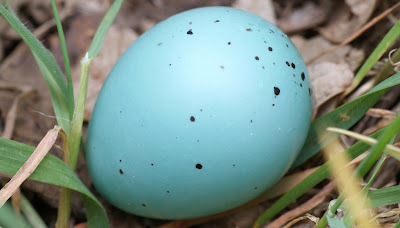 This is the first time I've come across this Shieldbug - Troilus luridus. I love the metallic colours and the way in which they blend together...and the antennae headlights are pretty impressive!
This is the first time I've come across this Shieldbug - Troilus luridus. I love the metallic colours and the way in which they blend together...and the antennae headlights are pretty impressive! Beautiful or what!! Male Orange-tip Butterfly.
Beautiful or what!! Male Orange-tip Butterfly. Soon after hearing a real clamour of various alarmed birds, I came across this Song Thrush egg at the base of a bramble. It was at the entrance of a small mammal run, so I wondered whether I'd disturbed a Stoat or Weasel, but a Magpie also flew off as I turned the corner - the more likely culprit, I feel!
Soon after hearing a real clamour of various alarmed birds, I came across this Song Thrush egg at the base of a bramble. It was at the entrance of a small mammal run, so I wondered whether I'd disturbed a Stoat or Weasel, but a Magpie also flew off as I turned the corner - the more likely culprit, I feel! The Adder's Tongue Fern is one of Duck End's special plants. You can see the two rows of reproductive spores on the spike, which gives the plant its name. The 'Green Oil of Charity' was the name of a poultice of this plant's leaves and rhizomes which was applied to wounds. A leaf tea of this plant was also given to people who were vomiting!
The Adder's Tongue Fern is one of Duck End's special plants. You can see the two rows of reproductive spores on the spike, which gives the plant its name. The 'Green Oil of Charity' was the name of a poultice of this plant's leaves and rhizomes which was applied to wounds. A leaf tea of this plant was also given to people who were vomiting! I should have posted this on Friday: April 23rd, St George's Day. This is the St George's Day mushroom - it was fruiting in Galler's Pasture.
I should have posted this on Friday: April 23rd, St George's Day. This is the St George's Day mushroom - it was fruiting in Galler's Pasture. Bigger bugs, like the Shieldbug above, can be very dramatic in appearance, but I find the smaller ones fascinating, too. Thanks to Bernard Nau & Sheila Brooke for helping me to identify this as Anthocoris nemoralis.
Bigger bugs, like the Shieldbug above, can be very dramatic in appearance, but I find the smaller ones fascinating, too. Thanks to Bernard Nau & Sheila Brooke for helping me to identify this as Anthocoris nemoralis. Thanks to our new Weevil Recorder, Wilf Powell, for identifying this Weevil as Rhynchites aequatus. It was swept from an apple tree by the entrance to the Reserve, and Wilf remarks that this species sometimes becomes a pest of cultivated apple trees.
Thanks to our new Weevil Recorder, Wilf Powell, for identifying this Weevil as Rhynchites aequatus. It was swept from an apple tree by the entrance to the Reserve, and Wilf remarks that this species sometimes becomes a pest of cultivated apple trees. Here's something I'm still working on which I thought would be straightforward - is this Ladybird a Cream-streaked Ladybird or a 10-spot Ladybird? The diagrams and photos I've come across look remarkably similar. The Cream-streaked Ladybird is more of a conifer specialist which would make it less likely, but I'm not a 100% convinced yet...I guess this is the best way of learning!
Here's something I'm still working on which I thought would be straightforward - is this Ladybird a Cream-streaked Ladybird or a 10-spot Ladybird? The diagrams and photos I've come across look remarkably similar. The Cream-streaked Ladybird is more of a conifer specialist which would make it less likely, but I'm not a 100% convinced yet...I guess this is the best way of learning!Update: Thanks to Helen from The Ladybird Survey, who has confirmed that this is a 10-spot Ladybird (colour form: decempunctata). Helen says that 10-spots are smaller and less domed than the Cream-streaked, but they are tricky to tell apart.
No comments:
Post a Comment